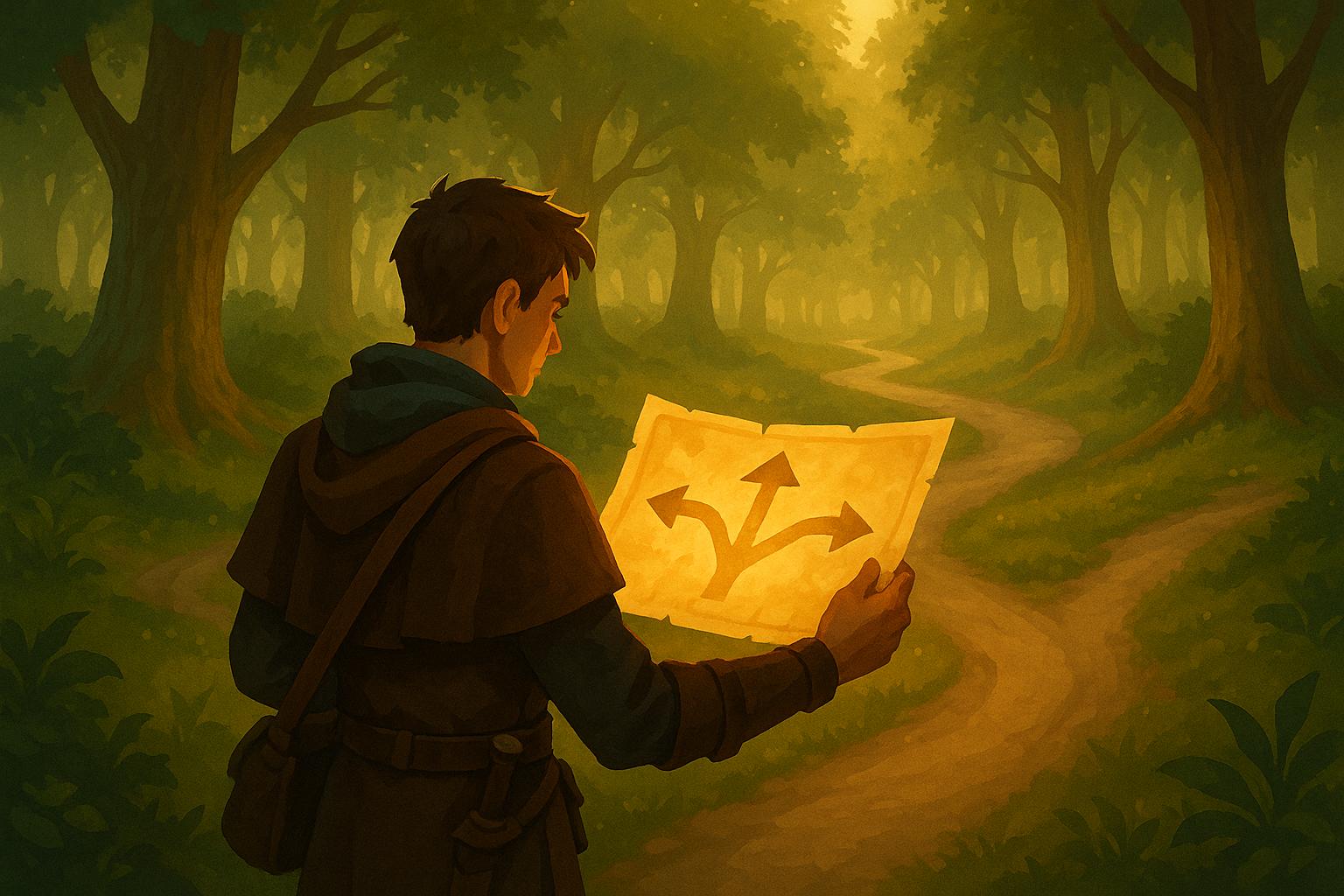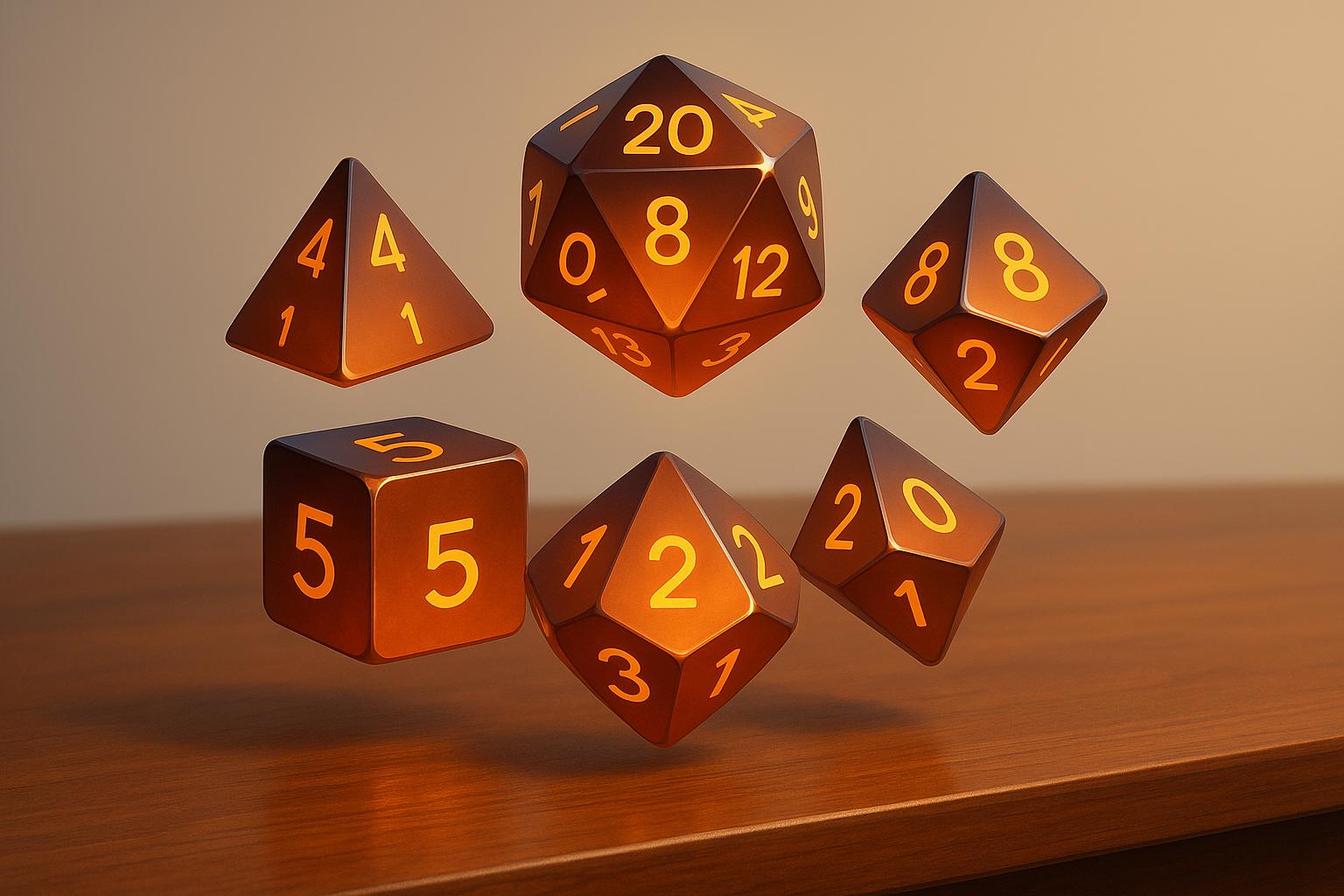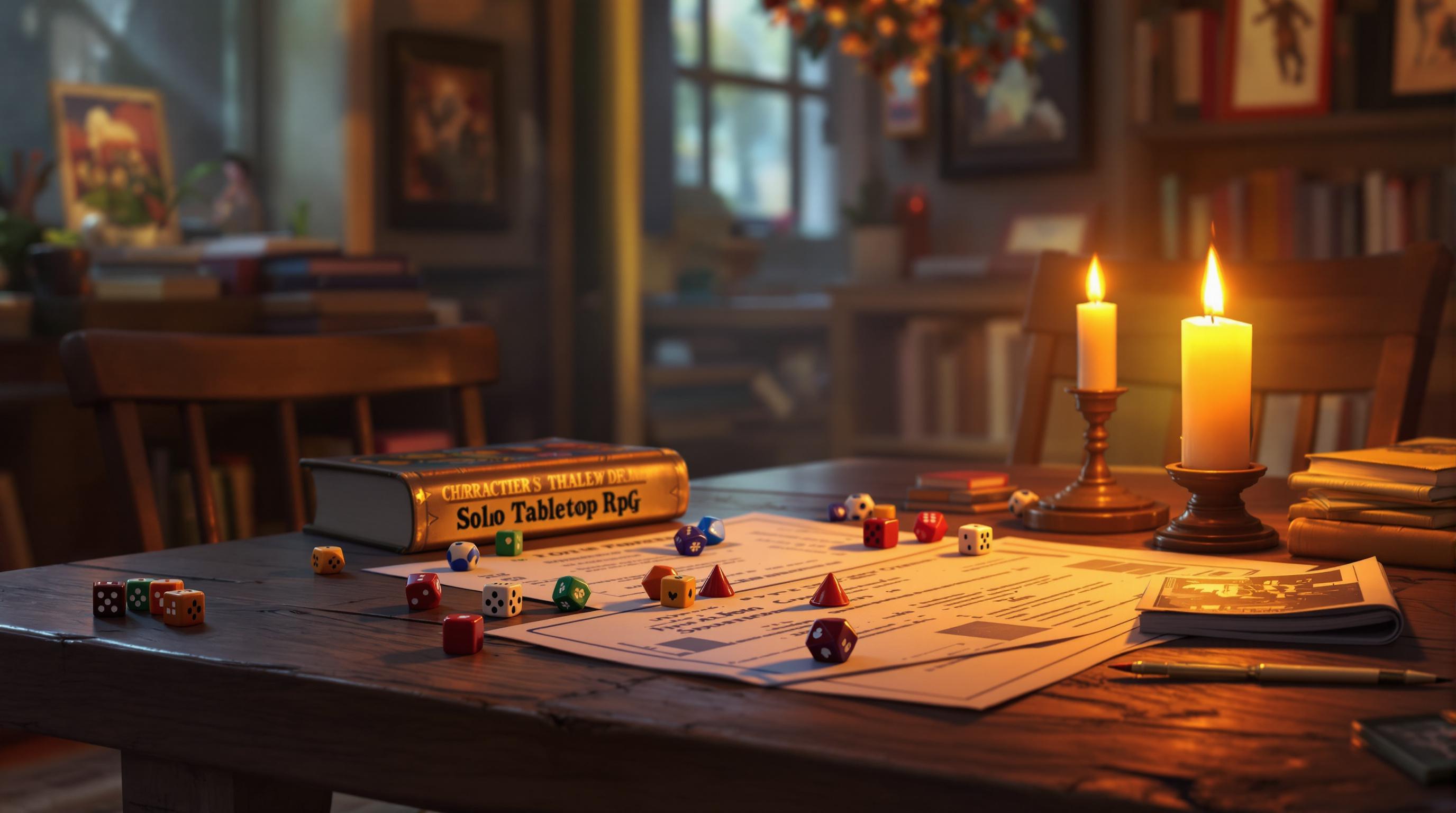Skill trees are systems for character progression in tabletop RPGs, offering branching paths where players make strategic choices to shape their characters. Unlike linear systems, skill trees provide flexibility and depth, balancing gameplay mechanics with storytelling.
Key Points:
- Nodes: The building blocks of skill trees, divided into Skill Nodes (abilities), Attribute Nodes (stats), and Special Ability Nodes (unique powers).
- Structures: Common layouts include Linear Progression (step-by-step) and Branching Systems (specialization paths).
- Progression: Players unlock nodes using points, often with prerequisites like levels or prior nodes.
- Narrative Integration: Skill trees can reflect character growth and tie into the story.
Quick Comparison Table
| Feature | Linear Progression | Branching Systems |
|---|---|---|
| Ease of Use | Simple and beginner-friendly | Requires strategic planning |
| Customization | Limited | High |
| Engagement | Predictable | Dynamic and varied |
Skill trees enhance gameplay by offering meaningful choices and connecting mechanics to the game’s story. Games like Star Wars Saga Edition, Pathfinder, and World of Darkness showcase how well-designed skill trees create engaging, immersive experiences.
Key Elements of TTRPG Skill Trees
Types of Nodes
Nodes are the building blocks of skill trees, shaping how characters grow and evolve. These are typically divided into three main categories:
| Node Type | Purpose | Common Examples |
|---|---|---|
| Skill Nodes | Core abilities and actions | Combat techniques, spellcasting, stealth |
| Attribute Nodes | Base character statistics | Strength, intelligence, dexterity |
| Special Ability Nodes | Unique character powers | Class-specific abilities, passive bonuses |
For instance, the Star Wars Saga Edition uses talent nodes that blend active abilities with passive perks. This design lets players create distinct character archetypes, adding depth to their choices [1]. How these nodes are arranged in the skill tree determines how players interact with them and the paths they can take.
Structures and Patterns
The layout of a skill tree can enhance both gameplay and player engagement. Effective designs balance freedom of choice with clear progression. Here are two common structures:
- Linear Progression: Simple and easy to follow, this structure is great for beginners. Players unlock abilities step by step.
- Branching Systems: These allow for more strategic decisions, enabling players to specialize at critical points.
A great example is Path of Exile, which uses a branching system to let players customize their characters while still maintaining a clear sense of direction [2]. Once the structure is decided, the focus shifts to how players unlock and move through these nodes.
Progression and Points
Unlocking nodes requires points, which are typically earned through leveling up or completing specific objectives. Progression systems often include prerequisites like:
- Character level thresholds
- Completion of prior nodes
- Meeting attribute requirements
The best systems strike a balance - offering enough complexity to keep things interesting without overwhelming players. By providing steady, meaningful choices, these systems ensure players remain engaged in their characters' development.
Creating Skill Trees for TTRPGs
Balancing Complexity and Ease
Designing skill trees for tabletop role-playing games (TTRPGs) is all about finding the sweet spot between depth and simplicity. The Star Wars Saga Edition offers a great example with its talent tree system. It keeps things manageable by limiting choices at each level while still allowing for meaningful character development [1].
Here are some key design principles to consider:
| Design Element | Purpose | How to Apply |
|---|---|---|
| Limiting Choices | Prevents decision fatigue | Offer 3-5 options per tier |
| Clear Descriptions | Avoids confusion | Use concise, straightforward language |
| Logical Progression | Maintains thematic consistency | Connect skills in a meaningful way |
Once complexity is under control, the focus shifts to creating choices that truly engage players.
Encouraging Player Decisions
The best skill trees challenge players with decisions that feel impactful. Pathfinder's feat system is a great example - it uses prerequisites and restrictions to encourage thoughtful planning [2].
To design skill trees with engaging choices, try these ideas:
- Include abilities that unlock new gameplay options, not just stat boosts.
- Offer branching paths that cater to different playstyles or character builds.
- Create clear trade-offs, so players weigh the pros and cons of specialization.
While these decisions influence gameplay, skill trees can also strengthen the connection between mechanics and storytelling.
Aligning with Game Narratives
Skill trees aren’t just about mechanics - they can also enrich your game’s story. World of Darkness does this well by tying abilities to character backgrounds and personalities, making progression feel like a natural part of the narrative [2].
Here are a few ways to align skill trees with your game’s story:
| Narrative Element | How to Implement | Why It Works |
|---|---|---|
| Reflecting Character Growth | Match abilities to backstories | Makes character progression feel organic |
| Tying Skills to Plot Development | Introduce abilities through the story | Adds depth to both mechanics and narrative |
When skill trees are both mechanically sound and narratively integrated, they enhance the overall player experience, making character progression feel meaningful and immersive.
Building Better Skill Trees
sbb-itb-b8b00a5
Using Skill Trees in Different TTRPG Systems
After creating skill trees, how they're implemented can vary widely depending on the system and genre. This shapes how players interact with them and how they influence gameplay.
Class-Based vs. Classless Systems
Class-based systems, like Dungeons & Dragons, provide structured roles and clear progression paths. On the other hand, classless systems focus on giving players the freedom to create unique builds without predefined roles.
| System Type | Advantages | Challenges |
|---|---|---|
| Class-Based | Easy-to-follow progress, Balanced gameplay, Defined roles | Limited customization options |
| Classless | High flexibility, Unique character builds, No role limits | Harder to balance, Complex choices |
For example, the Eternity TTRPG originally used a classless system to encourage flexibility. However, it later shifted to a class-based approach to prevent characters from feeling too similar.
Skill trees also adapt across different genres, reflecting the unique needs of each setting.
Skill Trees in Various Genres
In sci-fi horror, Mothership tailors its skill trees to emphasize survival and tension. Similarly, Shadows Over Sol integrates technical expertise into its hard sci-fi framework, making skills feel grounded in its futuristic world.
For fantasy settings, Pathfinder introduces skill feats and levels of expertise, such as untrained and legendary, adding depth to both gameplay and character progression. These mechanics also make downtime activities more engaging.
Examples of Effective Skill Tree Use
Some games take skill trees a step further by embedding them into the world and narrative:
- Traveller uses a lifepath system, where pre-game life decisions shape character skills, creating natural progression and rich backstories.
- World of Darkness strikes a balance between freedom and structure, giving players flexibility while maintaining helpful boundaries.
"Agency isn't so much players being free from consequence within a game as being fully aware of what the consequences of their decisions will be and being able to choose how they want to approach situations." - Leyline Press Author
Lastly, Shadowrun blends cyberpunk and fantasy, offering players the chance to specialize in areas like espionage while also mastering spellcasting. This dual-focus approach encourages creative, multi-faceted character builds.
Advanced Ideas in Skill Trees
Modern TTRPGs are constantly evolving, introducing new ways to design skill trees that enrich gameplay and keep players invested.
Multi-Class and Hybrid Systems
Multi-class and hybrid systems bring flexibility to character development by allowing players to mix abilities from different classes while keeping balance intact. The Star Wars Saga Edition RPG is a great example, letting players combine skills across classes without breaking the game.
| System Feature | Implementation | Benefit |
|---|---|---|
| Modular Trees | Separate but linked skill branches | Encourages creative character builds |
| Balance Gates | Level requirements and prerequisites | Avoids overpowered combinations |
| Specialization Paths | Focused progression routes | Rewards thoughtful planning |
These systems show how skill trees can be designed to support diverse strategies and playstyles.
Dynamic Skill Trees
Dynamic skill trees adapt based on player actions and in-game events, creating a personalized and engaging experience. Tyranny is a standout example, with a skill system that evolves according to the player’s choices.
For instance, certain abilities might only become available when players align with specific factions or reach key story moments. This makes progression feel natural and tied to the narrative, giving players a stronger sense of agency and connection to the game world.
Integration with Other Systems
Skill trees become even more impactful when they tie into other game mechanics. World of Darkness does this by linking skill progression to both character growth and the story.
"A good skill tree pushes the player to build a unique character, one that supports self-expression, one that will drive his engagement and appropriation." - GDKeys, "Keys to Meaningful Skill Trees" [2]
The key to success here is balancing complexity with ease of use. Dungeons & Dragons 5th Edition excels at this by integrating:
- Skills with narrative milestones
- Equipment options and synergy
- Social interaction mechanics
This kind of integration doesn’t just add depth - it makes every choice in the skill tree feel purposeful, leading to a richer, more strategic gameplay experience.
Conclusion: Skill Trees and Gameplay
Key Takeaways
Skill trees in TTRPGs give players the ability to shape their characters in meaningful ways through structured progression. The best designs strike a balance between being easy to understand and offering enough depth to keep players engaged, enhancing both the gameplay and the story.
| Design Principle | Impact | Implementation |
|---|---|---|
| Meaningful Choice | Allows for unique customization and lasting decisions | Clear specialization paths with strategic trade-offs |
| System Integration | Adds depth to gameplay | Ties into core mechanics and narrative elements |
The success of a skill tree depends on careful design. It should keep players engaged while maintaining balance in the game. Games like Star Wars Saga Edition and World of Darkness show how well-designed skill trees can make choices feel impactful and fit seamlessly into the story.
Resources for Inspiration: TTRPG Games Directory
Looking for ideas or examples of skill tree designs? The TTRPG Games Directory is a great resource. It offers detailed descriptions of mechanics from various games, helping you spot effective patterns in skill tree design. For instance, it covers everything from Basic Role-Playing System's percentage-based skills to more modern, hybrid systems.
Both designers and players can learn a lot by exploring different approaches to character progression. Whether you're analyzing proven systems or experimental ones, the most effective skill trees tend to share these features:
- Clear progression paths that cater to different playstyles
- Balanced complexity to avoid overwhelming players
- Integration with game systems and storytelling for a cohesive experience
When these elements come together, skill trees can create progression systems that deepen gameplay and boost player enjoyment.


